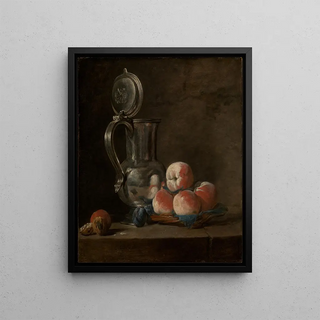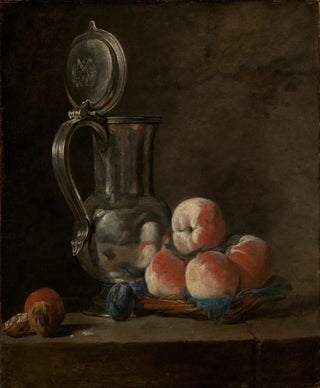Art print | Still life with a pewter jug and peaches - Jean Siméon Chardin


View from behind

Frame (optional)
In the rich and delicate universe of 18th-century French painting, the work of Jean Siméon Chardin stands out for its sensitivity and meticulous attention to everyday details. "Art print with a tin jug and peaches" perfectly embodies this approach, offering an intimate look at the beauty of simple objects. This composition, both humble and refined, invites the viewer to contemplate the poetry emanating from ordinary things. The warm tones and play of light create a serene atmosphere, conducive to reflection. By immersing oneself in this art print, one discovers not only a scene frozen in time but also an invitation to meditate on life and nature.
Style and uniqueness of the work
Chardin, an undisputed master of the genre of the art print, manages to transcend the simple representation of inanimate objects. In this piece, each element, from the tin jug to the sweetness of the peaches, is treated with a delicacy and precision that testify to a genuine love for the material. The textures are rendered with such finesse that one can almost feel the velvety of the fruits and the coldness of the metal. The light, omnipresent, plays a crucial role in the composition, highlighting shapes and colors while creating a warm ambiance. Chardin also uses a harmonious arrangement, where each object seems to dialogue with the others, revealing a subtle dynamic and unexpected depth. This unique style, combining realism and poetry, makes this work an emblematic example of the artist's talent.
The artist and his influence
Jean Siméon Chardin, born in 1699, managed to capture the essence of daily life at a time when art often turned to more grandiose themes. His ability to transform ordinary objects into subjects of deep contemplation marked a break with the conventions of his era. Influenced by the Baroque movement while distancing himself from it, Chardin cultivated a personal style that inspired many subsequent artists. His realistic approach and sensitivity to light and textures paved the way for generations of painters

Matte finish

View from behind

Frame (optional)
In the rich and delicate universe of 18th-century French painting, the work of Jean Siméon Chardin stands out for its sensitivity and meticulous attention to everyday details. "Art print with a tin jug and peaches" perfectly embodies this approach, offering an intimate look at the beauty of simple objects. This composition, both humble and refined, invites the viewer to contemplate the poetry emanating from ordinary things. The warm tones and play of light create a serene atmosphere, conducive to reflection. By immersing oneself in this art print, one discovers not only a scene frozen in time but also an invitation to meditate on life and nature.
Style and uniqueness of the work
Chardin, an undisputed master of the genre of the art print, manages to transcend the simple representation of inanimate objects. In this piece, each element, from the tin jug to the sweetness of the peaches, is treated with a delicacy and precision that testify to a genuine love for the material. The textures are rendered with such finesse that one can almost feel the velvety of the fruits and the coldness of the metal. The light, omnipresent, plays a crucial role in the composition, highlighting shapes and colors while creating a warm ambiance. Chardin also uses a harmonious arrangement, where each object seems to dialogue with the others, revealing a subtle dynamic and unexpected depth. This unique style, combining realism and poetry, makes this work an emblematic example of the artist's talent.
The artist and his influence
Jean Siméon Chardin, born in 1699, managed to capture the essence of daily life at a time when art often turned to more grandiose themes. His ability to transform ordinary objects into subjects of deep contemplation marked a break with the conventions of his era. Influenced by the Baroque movement while distancing himself from it, Chardin cultivated a personal style that inspired many subsequent artists. His realistic approach and sensitivity to light and textures paved the way for generations of painters






